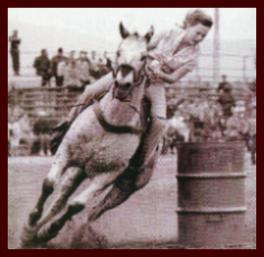JOKER B. Registration: ApHC
#F-678 |
 |
||||||
|
Foaled July 21, 1941, Joker B.'s arrival, although much anticipated was less than spectacular. When Jack Casement of Westplains, Colorado, bred his foundation Quarter Horse stallion, Red Dog P-55 to the unregistered mare Blue Vitriol, the last thing he expected was a black colt with, of all things, a big white blanket full of spots. This was simply unacceptable at Casement's Quarter Horse ranch. Although the blood of some of the greatest Quarter Horse lines of the times ran in Joker B.'s veins, he was obviously an Appaloosa. However, a quick look at the dam's side of Joker B.'s pedigree provides some answers as to where this color came from. Blue Vitriol, from Coke Roberds' breeding program, was sired by Brown Dick making her a half sister to Ding Bob P-269, a great Peavy stallion. But on her dam's side is where Joker B.'s claim to color becomes evident. Blue Vitriol was out of an own daughter of Old Fred, a mare named Leopard. Leopard's dam's dam was sired by the Appaloosa stallion Arab, giving Joker B. color five generations back. Like the "ugly duckling" of children's stories, Joker B.'s potential wasn't realized and before the young, distinctively marked colt reached six months old, he was given to Casement's wife Xenia. In short order, Xenia sold the spotted misfit to Jack Blasingame, a neighbor who'd admired the youngster, for $250, then promptly purchased herself a vacuum cleaner. Blasingame's appreciation for Joker B. lasted only two weeks. Bob Cantrall of Reno, Nevada, purchased the colt for $750, but a short time later Joker B. changed hands again when he was sold to Tommy Young of Las Vegas, Nevada. It was to Young that Joker B. owes his name. (Prior to Young's purchase the young colt was simply called "Domino." Young named him "Joker.") Young broke Joker, who incidentally roaned out to a dark blue, and began using him on the ranch. He also entered Joker in rodeos and used him as a bull-dogging, hazing and pickup horse. While on the rodeo circuit, Joker began to earn a reputation for himself as a steady, versatile horse. Although Young didn't concentrate on breeding Joker, he was willing to offer the stallion's services whenever needed -- for free. A NAME 1946 was a turning point in Joker's life. Lee Berry of Barstow, California, bought the five-year-old stallion for $1,500 and registered Joker with the fledging Appaloosa Horse Club. It was upon registration with the Club that Joker's name was finally completed with the addition of the letter B for Berry. Joker B. continued to be a familiar sight at the rodeos with Berry roping off the levelheaded stallion. Berry's wife, appreciative of Joker B.'s easygoing attitude, developed a specialty act in which she led a Brahman while her husband rode the bull. In 1949, Joker B. was registered with the American Quarter Horse Racing Association based on his pedigree and rodeo times.
Joker B.'s life was to take yet another turn as Bill Benoist became his sixth owner and the first to campaign the stallion, entering him at the National Show and building a breeding program around him. Benoist surrounded Joker B. with such mares as Miss Ritz, who produced Joker Boy, and Norell's Myrtle B and Bayarda-B who produced many champions including M.J.B., Mr. J.B., Arda-Joke B and Moka B.
Then, in 1959, at the ripe old age of 18, Joker B. was to change hands again. However, this transaction was to be the most significant of his life. He was purchased by an oil man from Texas -- Carl Miles. The stallion who wasn't worth more than a vacuum cleaner to his original owners was purchased for $10,000. CEE BAR APPALOOSA RANCH Miles, who'd been searching for the perfect horse to promote the Appaloosa breed, set great stock in his new stallion. And although Miles continued to show Joker B., the stallion's primary function was as an ambassador for the Appaloosa breed. He became the trusted mount for the likes of Texas Governor John Connally and Miss Texas Linda Loftis, and Dick Boone, who starred in the television series "Have Gun Will Travel," made a rodeo appearance atop the stallion. Joker B. even drew national attention when he and Cee Bar Ranch were featured on NBC's "Today" show. And Miles took Joker B.'s promotion one step further. Miles mounted an extensive advertising campaign featuring the stallion and his get in such magazines as Western Horseman and supplied framed reproductions of the Darol Dickinson Joker B. painting to hotels and restaurants across the country. Miles' broodmare band was just as grand as the promotions which surrounded the aged stallion. Exceptional Appaloosa and Quarter Horse mares were purchased, most in the $5,000-$10,000 range. Of the 13 progeny of Joker B.'s first foal crop at Cee Bar Appaloosa Ranch, eight were accomplished show winners. Throughout Joker B. and Miles' alliance, the stallion continued to produce winning get, and in 1965 he was awarded the Premier Sire Award No. 1 by the Texas ApHC. Due to Miles' tireless promotion of the stallion, Joker B., the once ugly duckling, had truly become a stockhorse phenomenon. As a final testimony to his belief in the stallion, Miles sold Joker B. at public action in November 1965. The grand old stallion was purchased for $25,000 by a four-man syndicate which included Miles. The syndicate then closed Joker B.'s books to outside mares. 1966 saw Joker B.'s final season at stud, and on July 13, he passed away due to old age. In 1988 he was inducted into the Appaloosa Horse Club Hall of Fame. {The above article and photograph were taken from an article, by Robin Hirzel, that appeared in the Appaloosa Journal, December 1997, Vol 51, No. 12, "Legends Joker B. The value of a vacuum cleaner" and are used here by permission.} Copyright © 1997 Appaloosa Horse Club. All rights reserved. |
|||||||
|
|||||||
|
|||||||
